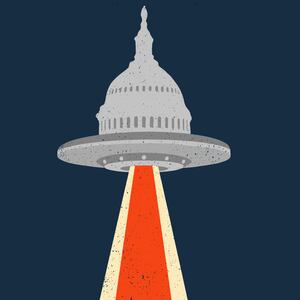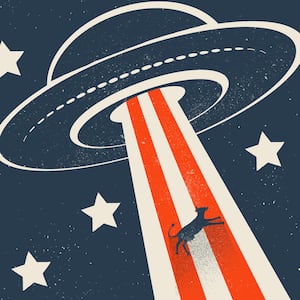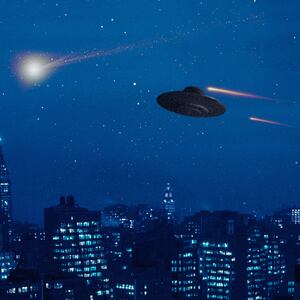The U.S. House of Representatives hearing on Wednesday morning about so-called unidentified anomalous phenomena—a.k.a. UAPs—was only mostly a clown show.
Ignore the rightwing religious rhetoric from some House Republicans; disregard some congresspersons’ insinuation that the White House is hiding aliens because it hates America; tune out the vague conspiratorial ramblings from one attention-seeking whistleblower. What’s left, after you filter out the bluster, is a compelling argument for a better system of centralizing, correlating, and vetting sightings of UAPs.
Lots of people have seen, or at least think they’ve seen, airborne objects they can’t explain. It’s been happening for decades. Despite the long history of UAP sightings—or, to use older terminology, unidentified flying objects, or UFOs—there’s no single reporting system.
ADVERTISEMENT
“Military witnesses to UAP have limited options,” Ryan Graves, a former U.S. Navy fighter pilot who had a close encounter with what looked like a flying gray cube off the coast of Virginia in 2014, told the House Subcommittee on National Security, the Border, and Foreign Affairs. “The commercial sector hasn’t adapted,” Graves added.
“A central UAP reporting system would help immensely,” Jacob Haqq Misra, an astrobiologist with the Blue Marble Space Institute of Science in Seattle, told The Daily Beast.
Today every military aviator, commercial pilot, or joe schmoe on the ground with a photo or video of a UAP has to decide on their own whether to share the imagery or even talk about it—then figure out some way of sharing their experience as well as the purported evidence of that experience.
That dearth of options was at the heart of Tuesday’s hearing—even if many of the subcommittee’s Republican members did their best to obscure the issue. Two of the three witnesses—Graves and another former Navy pilot who has had an encounter with what appeared to be a weird flying object—described in detail their strange meetings with strange aerial phenomena and practically begged for someone to figure out a new, better, and more open way of reporting them. Those compelling pleas for action were inexplicably met with responses to “our country to take back our country,” to borrow Rep. Tim Burchett’s (R-TN) unique phrasing.
A centralized, nonclassified reporting system—an app or website with sufficient quality control and plenty of metadata—might allow anyone with a photo or video of a UAP to add their sighting to a reliable database that lawmakers, academics, and the public can tap as they craft policy, conduct research and satisfy their own curiosity.
The same system might mitigate some of the stigma some witnesses feel when they try to explain to their colleagues and bosses that they saw something strange. A website doesn’t give anyone side-eye. “We need a system where pilots can report without fear of losing their jobs,” said Graves, whose testimony stressed how common encounters are between pilots and UAPs—and how reluctant many pilots are to discuss the encounters.
It should go without saying that what Graves described as “excessive classification” would neuter any effort to create a central repository for UAP sightings.
Avi Loeb, a Harvard physicist and noted UAP hunter, argued the government should go a step further and declassify any military UAP sightings that aren’t yet on the public record. “Here’s hoping that by allowing scientists to access the UAP data that the U.S. government may have, we will all get a better sense of whether there is evidence for cosmic neighbors in our backyard,” Loeb told The Daily Beast.
A universal, declassified method of reporting UAPs could let some of the hot air out of the paranoid balloon that hovered over the Tuesday hearing. “American people largely believe the government has actively covered up the truth about UAPs,” Rep. Anna Paulina Luna (R-FL) said in her opening statement.
Testimony by David Fraver, a former Navy pilot who tailed what he described as a Tic Tac-shaped UAP off the California coast in 2004, didn’t go as far as Luna in accusing the feds of a coverup. Indeed, Fraver said he was “treated very well” by his military chain of command in the aftermath of his close encounter.
Fraver said his Tic Tac maneuvered in ways no human-made craft possibly could. But that’s not what worries him the most when it comes to UAPs, he said. “What concerns me,” he stressed, “is there’s no oversight.”
Patchy oversight does not equal conspiracy. But tell that to Burchett, who blamed the spirit of the devil for corrupting government officials and impeding UAP disclosures.
Burchett practically donned a tinfoil hat when he asked the third and least credible witness, former U.S. intelligence official David Grusch, if the administration of President Joe Biden had ever murdered anyone who claimed to have seen a UAP. “I have to be very careful” discussing any alleged murders, Grusch replied, practically winking at the cameras. His testimony included claims that the government had previously recovered “non-human” biological remains from crashed UAPs, and that the government has been aware of the existence and activity of extraterrestrial beings since the 1930s.
Grusch’s insinuation of high crimes and a government cover-up was a distraction from Graves and Fraver’s valid point. “UAP are in our airspace, but they’re grossly underreported,” Graves said.
In this era of universal smartphone cameras, apps, and social media, there’s no longer any excuse for the absence of an unclassified reporting system that can capture a greater share of the world’s UAP sightings. At least one developer, New York City-based Enigma Labs, is working on a smartphone app for uploading UAP videos. But the app hasn’t really gone mainstream—perhaps because it’s a strictly private enterprise without a big government sponsor that would make it the “official” UAP app.
The need for a universal UAP reporting system is only going to intensify. Loeb has been building a network of rooftop sensors that he and his team have designed for spotting and recording UAPs. “We want to cover the entire sky at all times with multiple sensors, so that we will not be fooled by just one of them, and classify objects based on their image and trajectory in the sky,” Loeb said.
If Loeb can find the money and expand the network from its current tiny scale—one installation in Cambridge, Massachusetts—to something truly global, the number of credible UAP sightings could grow by a lot.
The speakers at the Tuesday hearing were wrong about many things. But they weren’t wrong that we need a better way of capturing, vetting, and sharing UAP sightings.








